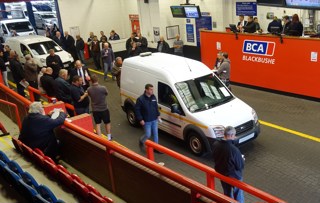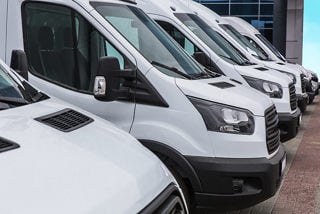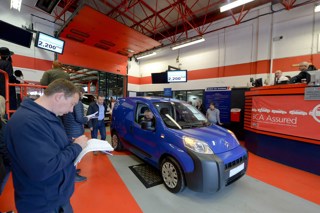This month's remarketing insight shows that the retail and construction sectors have boosted the LCV demand, Dean Bowkett reports.
After the summer breeze, autumn used sales continue to flourish helped by manufacturers resisting the temptation to offer big discounts on new purchases.
The idea that “we’re all going on a summer holiday” (with apologies to Cliff Richard et al) seems to be something which passed by buyers of light commercial vehicles (LCVs) this year.
Used LCV sales stayed strong during the warm months and even showed increases, rising every month through June (1.8%), July (1.1%) and August (1.5%).
Cap HPI reported unseasonably strong LCV sales throughout the summer although its latest editorial indicated a decline for the September trade sales volume forecast. It put this down to a lack of supply to meet demand.
However, the auction houses are not currently reporting such falls and are generally far more optimistic around supply, demand and prices.
Andy Picton, Glass’s commercial chief editor, sided with the auctions, saying that, from its perspective, September saw a 8.7% increase in sales volume compared with September 2016.
While new LCV sales remain down (2.8%) for the first eight months of the year, the strong used LCV take-up indicates that consumer demand, which is the major driver of GDP growth, plus the increasing move towards online retail sales is creating a need for LCVs.
This is especially the case as we head towards the busiest retail period of the year.
The demand is particularly strong among small city/car-derived-vans and medium-sized vehicles, especially in the two-to-four-year-old range with the latter accounting for 40% of September’s sales.
BCA LCV operations director Duncan Ward confirmed online shopping delivery continues to be behind the improving demand.
He added that BCA had also seen it coming from “the construction and civil engineering industries and small businesses and entrepreneurial start-ups”.
With smaller vans such as the car-derived ones being perfectly suited to meet the needs of online deliveries, Glass’s noted that, in spite of large volumes of VW Caddy and Ford Transit Connect coming through the auction houses, there was little difficulty in shifting the majority of the volume of vehicles at this smaller-sized end of the market.
The LCVs that were sticking were those with a lower specification – for example the base level, low-powered 75PS derivatives.
On the used LCV valuation front, BCA reported record levels in September with the headline value rising 5.1% from August to £6,651, with fleet and lease and part exchanges also hitting record levels.
The year-to-date position is also showing a contrast to the falls seen in new LCV sales with year-on-year used LCV values up by 8.3% (£531).
However, with the average age falling 2.23 months to 51.92 and mileage dropping 9.2% to just under 65,000 miles the growth is a lot more modest than the headline numbers suggest, but it is still heading upwards.
Glass’s also saw values increasing with a 1.8% rise over August and up 2.6% over September 2016.
This trend shows no sign of abating and, with supply and demand remaining well balanced, this upward momentum looks likely to continue for the remainder of the year.
Interestingly, BCA noted that younger LCVs are also faring well. The average age rose to 9.35 months from 9.05 last year and mileage increased by 7.3% to £11,355.
But, despite the vehicles being older and with higher mileage, the average value increased by 1.8% to £14,636 over the previous year.
Given the drop in new LCV sales it would appear some buyers are avoiding new vehicles for nearly new ones.
The fact that manufacturers are shying away from heavily discounting new LCV sales is having a positive impact in shoring up younger used LCV values, according to BCA analysis.
This view is shared by Alex Wright, MD of Shoreham Vehicle Auctions (SVA), who confirmed “a nice price gap between the nearly new demonstrator stock in the market and the three-year-old van market so as not to damage prices of the latter”.
This means the market remains stable and is not being distorted by forced new LCV sales.
Wright also noted a hesitancy among LCV buyers concerning Brexit.
This has resulted in smaller companies “looking to spend £10,000-15,000 on a good quality used van rather than buying or financing £25,000-30,000 for a new one.”
He pointed out that while low interest rates and low unemployment provide stimulus to invest in replacement LCVs, the higher inflation and a weaker sterling pushes SMEs to be more prone to buy used over new.
With the Bank of England governor Mark Carney stating that he expects inflation to rise above 3%, this switch from new to used may gain further momentum during the remainder of this year and into 2018, which can only support further increases in used LCV prices.
Despite an increase in stock availability, conversion rates remain high with BCA’s Ward confirming that “demand was strong across the board, with corporate vendors enjoying excellent conversion rates”.
Demand and supply are getting so strong BCA has even added an additional LCV sale to its Glasgow site on Monday afternoons, as well as twice weekly sales at its newly expanded Manchester site.
SVA is also seeing high conversion rates continuing after everyone returned from their summer breaks, while Glass’s reported a 4% increase in conversion rates over last month and a 2% uplift over the same period last year.
While most auctions are continuing to say it is the good quality and fully documented vans which are most sought after, Cap HPI has noted that its own independent condition assessments are showing a 14% increase in the average amount of damage on vehicles.
Given the fact that average prices are still rising, it could indicate that there may be a shortage of supply from some makes and models that is encouraging buyers to pay more for vehicles in less than prime condition.
However, Glass’s has seen some of the “less tidy examples struggling” so it is more likely the mix of vehicles and specifications that is impacting values as much as anything to do with condition.
The days of utilitarian specification LCVs has become a thing of the past.
Buyers of new LCVs have consistently sought similar levels of comfort and ease of driving that they enjoy with their cars and this has clearly filtered down into the used van market.
According to Glass’s, the “greatest demand is for the highest specified vans often with air-con, metallic paint and auto gearboxes”.
With the used van market mainly driven by the SME sector, it is not surprising that this demand for car style levels of comfort has crept in.
They are also looking for small- and medium-sized vans, which made up more than 70% of all used LCV sales in September, according to Glass’s.
With the buoyant summer behind us, the autumn has started with more of the same with values and volumes on the rise.
Demand continues to keep up with supply and there are even signs that it is starting to creep ahead in some cases, providing a boost for certain models of the right size, specification and condition.
By Dean Bowkett




















Login to comment
Comments
No comments have been made yet.